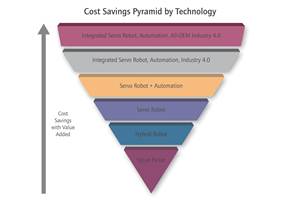On the Cutting Edge in Structural Foam
In structural foam, as in any area of plastics, keeping abreast of the latest technology is a key to competitiveness.
In structural foam, as in any area of plastics, keeping abreast of the latest technology is a key to competitiveness. For 20/20 Custom Molded Plastics Ltd. in Holiday City, Ohio, that has meant using independent multi-nozzle injection control and robotic parts handling. “It is surprising, but the majority of structural-foam molders today still do not have these latest advantages, so they are falling behind,” says 20/20 president Ron Ernsberger.
His firm’s 90,000-sq-ft plant houses five structural-foam presses from Uniloy Milacron, Tecumseh, Mich. They range from three 500-tonners to a 1000-ton machine and a 1500-ton behemoth said to be the largest in the country. It can run up to 5000 lb/hr, and the whole plant can consume 300,000 lb/day. “We have the highest structural-foam tonnage and capacity of any custom molder,” claims Ernsberger. Foam makes up more than 80% of the firm’s $25 million sales. The rest is structural-web molding and standard injection molding (on four presses of 375 to 726 tons).
Multi-nozzle control
“We sell machine time, so getting as many projects on a platen and running with little scrap is key,” says Ernsberger. Tighter nozzle control lets 20/20 run structural foam in 32, 48, and even 64 cavities without flash or short shots. Such high cavitation is a new frontier for structural foam and is made possible by improved control of the filling process, according to Ed Hunerberg, director of structural foam at Uniloy Milacron.
Just a few years ago, molders controlled material flow to a nozzle by restricting its diameter with a mechanical adjustment. This balanced filling of larger and smaller molds on the platen. But this approach could mean extended downtime for nozzle adjustments when molds were changed.
“Molders would typically limit the number of molds or cavities on a platen or the speed of the press due to shot-to-shot variations,” adds Erns-berger. “You could lose up to 20% of your cavitation and take a 20% to 30% hit on cycle time just to prevent scrap. But mold filling could still vary, making part weights range widely.”
Today, he notes, “Electronic closed-loop multi-nozzle control allows us to run the nozzles wide open with no restrictions in the melt channel. We can open the nozzles at the same time and close them at different times, controlling the fill volume. The ability to control the shot size and speed when you open and close the nozzles, and the ability to sequence those changes—this is all new to the machinery,” says Ernsberger. “I can shoot through all nozzles at once, or just a pair of them, or do it individually.” He says this is particularly helpful for injecting two materials or colors into different molds on the platen.
Hunerberg says multi-nozzle control has been available for at least five years, but molders are just now realizing its benefits. “We control part weights to hundredths of a pound, rather than tenths, and shot repeatability is just as tight, which helps maintain uniform part density.”
20/20 also can program nozzles to open at specific times in order to move a weld-line position. “You can move material where you need it to lower part weight and save on cycle time,” Ernsberger adds. Better injection-velocity control ensures more consistent part weight, which results in 3% to 5% material savings, he says. “With the latest controls we are able to take tools we have run in the past and produce the parts in 30% less time and with higher quality.”
Robots lend a hand
Automation is another trend that’s fairly new to structural foam. 20/20 recently added 4-axis, beam-mounted servo robots from Ranger Automation Systems, Shrewsbury, Mass., to each of its foam machines. “The parts are so big, and there so many per shot, that it is cumbersome to handle them manually,” notes Ernsberger. “Automation saves on wear and tear on our people and it maintains cycle time because the machine does not wait for an operator to open or close a gate. This also means lower scrap rates.”
Equipped with a wrist movement to turn and flip parts, 20/20’s robots trim gates, deflash parts, and complete as many secondary tasks as possible. The larger presses even use two robots on a single beam.
Related Content
Drones and Injection Molding Ready for Takeoff
Drones and unmanned aerial vehicles (UAV) are approaching an inflection point where their production volumes — and functionality — will increasingly point to injection molding.
Read MoreHow Was K 2022 for Blow Molding?
Over a dozen companies emphasized sustainability with use of foam and recycle, lightweighting and energy savings, along with new capabilities in controls, automation and quick changeovers.
Read More50 Years...600 Issues...and Still Counting
Matt Naitove marks his first half-century in plastics reporting, with a few of his favorite headlines.
Read MoreAutomation Evolution: From Robots to Work Cells, Solo Devices to Integrated Systems
Injection molding automation has progressed from devices to systems, from simplicity to more complex capabilities. The author traces this development through various levels of automation – all still available choices today – and analyzes the costs and capabilities for each level.
Read MoreRead Next
People 4.0 – How to Get Buy-In from Your Staff for Industry 4.0 Systems
Implementing a production monitoring system as the foundation of a ‘smart factory’ is about integrating people with new technology as much as it is about integrating machines and computers. Here are tips from a company that has gone through the process.
Read MoreTroubleshooting Screw and Barrel Wear in Extrusion
Extruder screws and barrels will wear over time. If you are seeing a reduction in specific rate and higher discharge temperatures, wear is the likely culprit.
Read MoreAdvanced Recycling: Beyond Pyrolysis
Consumer-product brand owners increasingly see advanced chemical recycling as a necessary complement to mechanical recycling if they are to meet ambitious goals for a circular economy in the next decade. Dozens of technology providers are developing new technologies to overcome the limitations of existing pyrolysis methods and to commercialize various alternative approaches to chemical recycling of plastics.
Read More.png;maxWidth=970;quality=90)






.png;maxWidth=300;quality=90)


















